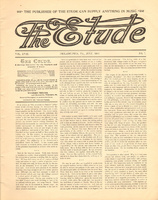BY ALFRED VEIT.
Very little is known as to Raff, the pianist. The career of the composer is familiar to everyone, but as to his ability as a pianist his contemporaries have scant to say. And yet Raff has written some charming pianoforte music indicating his thorough knowledge of the instrument. Thus, his “Suite in D,” opus 91, containing the magnificent “Guigue and variations”—a favorite concert number of Hans von Bülow—and his “Frühlingshoten,” opus 55, a collection of delightful pieces of which “Am Abend” is a gem, are well known to lovers of pianoforte literature, not to mention “La Fileuse,” of course. It is a curious fact, therefore, to find the “Thirty Progressive Etudes,” by Raff, Steingräber edition, comparatively unknown.
These etudes, which might serve as an introduction to Cramer, contain quite a few studies of great technical merit. The first one is made up largely of a two-finger figure. There are several canons, several fugues (the latter not always appropriately named), on G, A, D, E; also on the initials of F, H(iller), and F(ranz) L(iszt); a “Jagdstück,” a study in D-flat on the trill, and in conclusion a “Moto Perpetuo,” not too difficult, and, if brilliantly played, rather effective for concert use by pianists possessing a medium technic. Raff’s fluent style of writing for the pianoforte is prominently shown in these etudes, which are certainly to be recommended to the earnest student and the conscientious teacher. A work of quite a different caliber is the “Twenty-four Etudes de mécanisme et de Style dans Tous les Tous Majeures et Mineurs,” for the piano, by Josef Wieniawski, opus 44. A clue to the degree of difficulty will be given by simply mentioning the names of the artists to whom the various etudes are dedicated: Rubinstein, Moszkowski, Scharwenka, Sgambati, Diemer, Planté, Bülow, d’Albert, Grünfeld, Leschetitsky, de Pachmann, etc. Even Count Géza Zichy, the well-known one-armed pianist, is not forgotten, and has an etude for the left hand alone placed to his credit. The etudes are by no means as difficult, however, as the dedications would lead one to suppose.
Wieniawski was an excellent pianist in his times, of whom Leschetitsky thought a great deal. In these etudes he shows sound scholarship and keen insight as to the technical requirements of the instrument. It is therefore surprising, like in the case of the etudes by Raff, mentioned above, that these etudes are so little known. They cannot, of course, be compared to the Chopin etudes, which will always remain the highest pinnacle in the literature of etudes for the piano, until a genius equal to that of Chopin arises. But in workmanship and scope they compare favorably with works of a similar character published within recent years. Of especial value to the student will be found the etudes in thirds, dedicated to Louis Diemer, and the one in octaves, dedicated to Alfred Grünfeld. A fine “Andante Cantabile,” in C-sharp minor, and dedicated to Leschetitsky, will afford opportunity for study in melody playing. One of the interesting points of the collection is the cleverness with which Wieniawski has shown the characteristics of each pianist in silhouette fashion by introducing his various peculiarities. Thus, in the etude dedicated to de Pachmann pearl-like runs in scales recall that pianist; a fugue dedicated to Charles Hallé reminds one of the austerity of that artist, while, in the etudes dedicated to Schulhoff and Litolff, we hear echoes of the “Valse Brilliante” in D-flat and the “Spinning Song.” Taken as a whole, the collection will form excellent preparatory material for the etudes by Chopin.



